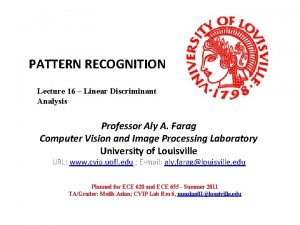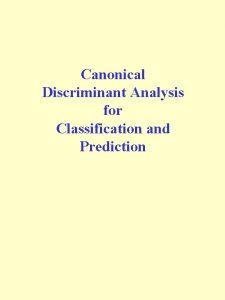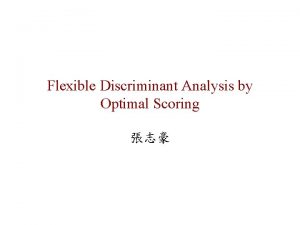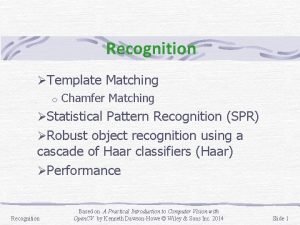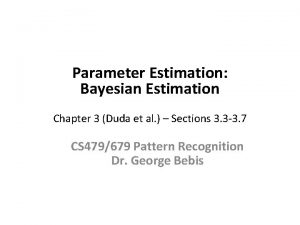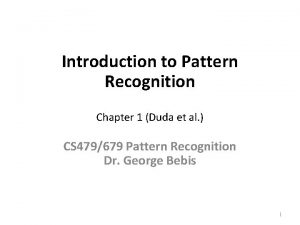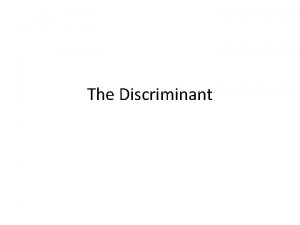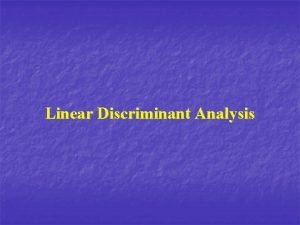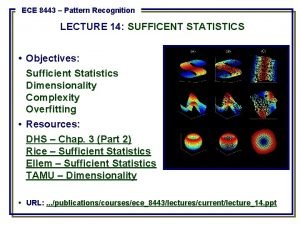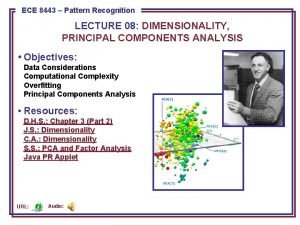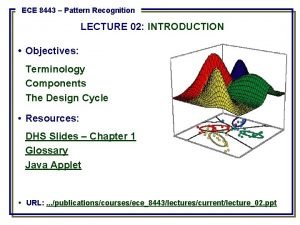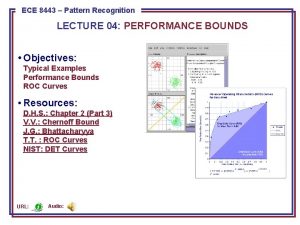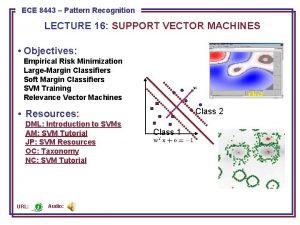ECE 8443 Pattern Recognition LECTURE 09 LINEAR DISCRIMINANT










- Slides: 10

ECE 8443 – Pattern Recognition LECTURE 09: LINEAR DISCRIMINANT ANALYSIS • Objectives: Fisher Linear Discriminant Analysis Multiple Discriminant Analysis Examples • Resources: D. H. S. : Chapter 3 (Part 2) W. P. : Fisher DTREG: LDA S. S. : DFA URL: Audio:

Component Analysis (Review) • Previously introduced as a “whitening transformation”. • Component analysis is a technique that combines features to reduce the dimension of the feature space. • Linear combinations are simple to compute and tractable. • Project a high dimensional space onto a lower dimensional space. • Three classical approaches for finding the optimal transformation: § Principal Components Analysis (PCA): projection that best represents the data in a least-square sense. § Multiple Discriminant Analysis (MDA): projection that best separates the data in a least-squares sense. § Independent Component Analysis (IDA): projection that minimizes the mutual information of the components. ECE 8443: Lecture 09, Slide 1

Discriminant Analysis • Discriminant analysis seeks directions that are efficient for discrimination. • Consider the problem of projecting data from d dimensions onto a line with the hope that we can optimize the orientation of the line to minimize error. • Consider a set of n d-dimensional samples x 1, …, xn in the subset D 1 labeled 1 and n 2 in the subset D 2 labeled 2. • Define a linear combination of x: and a corresponding set of n samples y 1, …, yn divided into Y 1 and Y 2. • Our challenge is to find w that maximizes separation. • This can be done by considering the ratio of the between-class scatter to the within-class scatter. ECE 8443: Lecture 09, Slide 2

Separation of the Means and Scatter • Define a sample mean for class i: • The sample mean for the projected points are: The sample mean for the projected points is just the projection of the mean (which is expected since this is a linear transformation). • It follows that the distance between the projected means is: • Define a scatter for the projected samples: • An estimate of the variance of the pooled data is: and is called the within-class scatter. ECE 8443: Lecture 09, Slide 3

Fisher Linear Discriminant and Scatter • The Fisher linear discriminant maximizes the criteria: • Define a scatter for class I, Si : • The total scatter, Sw, is: • We can write the scatter for the projected samples as: • Therefore, the sum of the scatters can be written as: ECE 8443: Lecture 09, Slide 4

Separation of the Projected Means • The separation of the projected means obeys: • Where the between class scatter, SB, is given by: • Sw is the within-class scatter and is proportional to the covariance of the pooled data. • SB , the between-class scatter, is symmetric and positive definite, but because it is the outer product of two vectors, its rank is at most one. • This implies that for any w, SBw is in the direction of m 1 -m 2. • The criterion function, J(w), can be written as: ECE 8443: Lecture 09, Slide 5

Linear Discriminant Analysis • This ratio is well-known as the generalized Rayleigh quotient and has the well -known property that the vector, w, that maximizes J(), must satisfy: • The solution is: • This is Fisher’s linear discriminant, also known as the canonical variate. • This solution maps the d-dimensional problem to a one-dimensional problem (in this case). • From Chapter 2, when the conditional densities, p(x| i), are multivariate normal with equal covariances, the optimal decision boundary is given by: where , and w 0 is related to the prior probabilities. • The computational complexity is dominated by the calculation of the withinclass scatter and its inverse, an O(d 2 n) calculation. But this is done offline! • Let’s work some examples (class-independent PCA and LDA). ECE 8443: Lecture 09, Slide 6

Multiple Discriminant Analysis • For the c-class problem in a d-dimensional space, the natural generalization involves c-1 discriminant functions. • The within-class scatter is defined as: • Define a total mean vector, m: and a total scatter matrix, ST, by: • The total scatter is related to the within-class scatter (derivation omitted): • We have c-1 discriminant functions of the form: ECE 8443: Lecture 09, Slide 7

Multiple Discriminant Analysis (Cont. ) • The criterion function is: • The solution to maximizing J(W) is once again found via an eigenvalue decomposition: • Because SB is the sum of c rank one or less matrices, and because only c-1 of these are independent, SB is of rank c-1 or less. • An excellent presentation on applications of LDA can be found at PCA Fails! ECE 8443: Lecture 09, Slide 8

Summary • Introduced Component Analysis. • Defined a criterion that maximizes discrimination. • Derived the solution to the two-class problem. • Generalized this solution to c classes. • Compared LDA and PCA on some interesting data sets. ECE 8443: Lecture 09, Slide 9
 Discriminant function in pattern recognition
Discriminant function in pattern recognition Canonical discriminant analysis
Canonical discriminant analysis Scoring matrix
Scoring matrix 01:640:244 lecture notes - lecture 15: plat, idah, farad
01:640:244 lecture notes - lecture 15: plat, idah, farad Cupe8443
Cupe8443 Cupe 8443
Cupe 8443 Cupe 8443 collective agreement
Cupe 8443 collective agreement Cupe 8443
Cupe 8443 Template matching pattern recognition
Template matching pattern recognition Bayesian parameter estimation in pattern recognition
Bayesian parameter estimation in pattern recognition Introduction to pattern recognition
Introduction to pattern recognition
